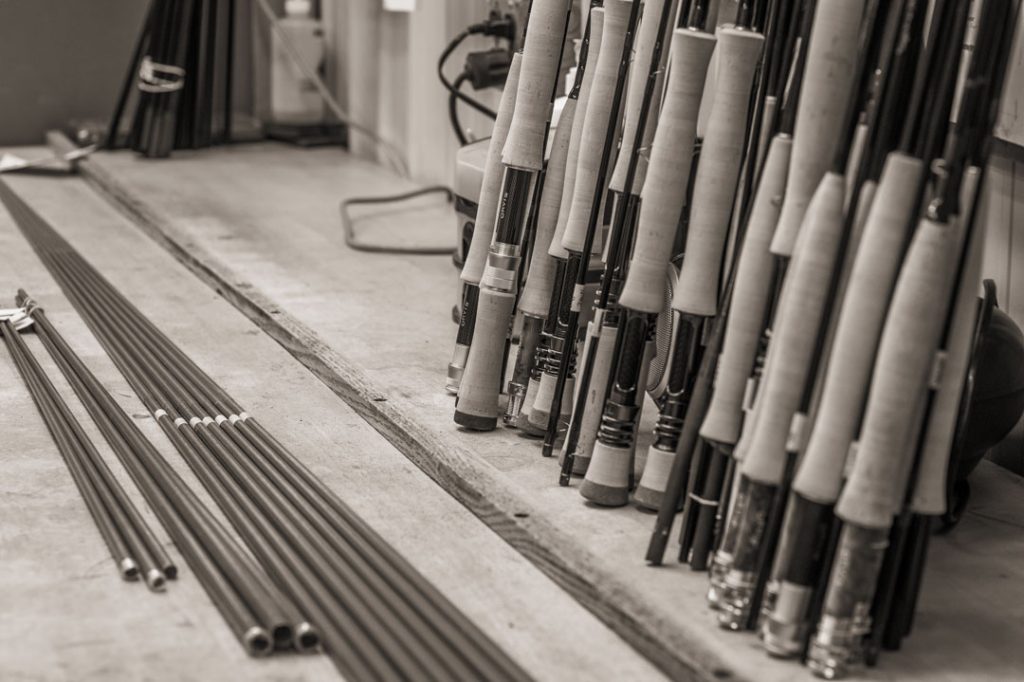
A couple generations ago, a certain fly rod manufacturer (starts with “O”) came up with the idea of covering every high end rod it sold with a 25-year warranty. And soon, other companies had little choice but to follow suit to stay competitive.
In some cases, those warranties were “unconditional.” So, it didn’t matter if your dog ate your rod handle, or you broke the tip off in a screen door. You were covered. Send it back… boom… you get a new rod, or at least a new part to restore your broken rod. In some cases, you had to pay the postage, but in others (I remember well) all you had to do was walk that broken rod back into the fly shop where you bought it, and the shop would ship it back, and call you (usually days later) when your fixed rod was ready to get picked up.
All of this was radically insane. I mean, imagine if golf club manufacturers guaranteed a replacement of the 7-iron you wrapped around a tree stump after you flipped out over an errant shot, or a ski manufacturer sent you a new ski every time you ripped an edge in a run full of rocks or tree stumps. Crazy, right?
But this was, collectively, a really bold move (though some companies complied, kicking and screaming), because it suddenly justified charging what seemed like exorbitant prices–like $400 (oof)–for a single fly rod! But if you did the math from either direction, it made perfect sense–to Joe Consumer, he had a lifetime rod for $400, and for the manufacturer, the reality was that only every three or four people would actually, ultimately break and send a rod in for repair, so they were in the de-facto insurance business, where everyone had to pay, “just in case,” but far less than half actually called in the chips. (See the interesting results of our latest Angling Trade survey, which indicates that people still either break few, if any rods, or a bunch…)
What has transpired over the past couple generations is interesting, because time became the come-uppance. People actually DID break their fly rods over time… maybe not the year after they bought it… maybe 15 years later… which was still covered by a 25-year unconditional warranty, or a lifetime warranty.
And now, if you were to rank the “rod shops” in the United States in terms of how many units go out the door every year, Sage and Orvis would undoubtedly be at the top of the pile somewhere, but their respective repair shops would not be far behind the factories themselves.
All of this led to a very interesting conundrum, where most rod companies have “adjusted” (let’s not say “backpedaled” because that’s not true for all of them) on the rod warranty issue. But the truth is that today, while most angling consumers almost consider the purchase of a fly rod to come with an “unconditional” warranty, the fact is that is not at all true, and the operative word here is “unconditional.” And to their credit, many of the rod manufacturers have been clear–at least in fine print–in explaining all that.
So where does it stand now?
Well, it really boils down to semantics, but consumers should read that fine print when they buy a rod, and know that all warranties are not created equal. And equally-important factors to consider are whether you want a “replacement” or you want “your” rod fixed, how fast you want it, and what you’re willing to pay.
Angling Trade magazine is in the middle of a test where we sent broken rods back to most of the major manufacturers, and we’re going to rate the experiences in terms of cost, timing, and more. While we’re not ready to hand out final grades, and won’t be for several months (because that’s how long it takes some companies to fix broken rods these days), we have already learned that the warranty repair scene is not at all equal–not even close.
Consider Sage.
Sage does not offer an “unconditional” warranty. Sage doesn’t claim to do so. If you read the warranty that comes with any Sage rod you buy, it’s as plain as day.
What Sage offers is the ability to fix your exact rod, for a (relatively small) fee. And that fee goes up, the older the broken rod is. So you have to pay to ship the rod back (there’s a form and process) and they evaluate it… and then they get back to you and tell you how much it will cost to fix it. For a recent model, it’s $50, for older models, it might be closer to $200. If they determine it to be a manufacturer defect, it’s free.
I just sent Sage three rods for repair, two “One” models, and one “X.” Sage got back to me and told me that one of the One models was covered by manufacturer warranty, and the other was my fault, but they could fix it for just under a hundred bucks. I have no idea how the company determined one rod to be their deal, and the other mine, because I broke them both (one a 4-weight, the other a 5-weight) almost exactly the same way. The X was on me, as I ran over it with my truck, but they say it’s only going to cost me $50, and I think that’s fair.
It’ll take a couple months to get them back. I don’t have a problem with any of that, and here’s why: Sage is going to fix those rods and build the broken parts exactly to match the rods I had (and loved). I’ve built affinity and connection to those rods. I bought them with good reason, and I don’t necessarily want different rods.
If the bridge or fretboard on my Martin OM-28 guitar that I’ve been playing for 20 years were broken, would I want a whole new guitar, or would I want MY guitar fixed? I’d want the latter, and such is the case with the Sage rods.They’re artifacts, they’re personal, and it’s an amazing service and capability that Sage can get you your “same” rod, albeit in several weeks, for $50 bucks or so.
Orvis, on the other hand, is all about getting you back on the water. Break the rod, and within five days, you’re good. There’s immense value in that also.
Hardy (Pure Fishing) reserves the right to replace an older model you break with a newer one, for a fee, at their discretion. It’s all spelled out on the warranty card.
Scott and Winston offer straight-up deals. You break it, you print the form and send them your credit card number, and they’ll fix it and send it back, for far less than it will cost to replace the rod entirely.
Trust us, we will give you the final grades on the real “value” of warranties, and who delivers on what they say they will.
But the important thing to know is that all warranties are NOT at all created equally, and you really need to read the fine print, and understand what you’re really looking for, because that’s a major factor in the overall value proposition when you buy a fly rod.
The thing is… many people don’t even know how different the warranty promises really are.
Do you?



2 Comments
You forgot to mention that it will take months to get your Sage back. Their current turn around is 10-13 weeks. So you should also know the process/timing ramifications on warranty/repairs. You have to send your Sage in because yes it is ‘custom’ and needs exact fitting of replacement parts.
Contrast that to Redington, who allows you to buy a replacement tip for $30 inclusive of shipping and you will get it in a few business days.
Not that one is better than the other…just to your point, knowing what you are getting into from repair perspective before you buy is a good idea.
For me I’d probably break the rod just before a big trip and be faced with buying a whole new rod because I had a Sage with long repair cycle…or shelling out $30 for a new Redington tip that I’d get in less than a week. I know which option I like.
Comparing Scott, Sage, Winston, or any domestic rod maker with Hardy, Redington, Echo, or any other “offshore” maker is apples and oranges. Domestic makers either rebuild the rod from pieces on hand, built from the same materials on the same mandrels, or build the replacement pieces with the aforementioned material and mandrels. Sometimes, if the rod has been out of production for a while, getting the original materials can be an issue as technology keeps moving forward. Repairs can take much longer in those cases.
Imported rods are easier to replace or repair as they simply take a percentage of the shipment and set them aside for parts. Since costs are a fraction of domestic production, this pencils out for them. Like imported waders, it’s cheaper to replace than repair as production costs are lower. Manufacturers are banking on a small percentage of buyers needing repair services.
As domestic rod prices continue to climb, perhaps switching to an optional “insurance” policy would be better than calling it a warranty. Insured rods would have a deductible to cover shipping and handling. Unusured rods would still be repaired but at actual cost. They would also be less expensive to purchase. Perhaps if anglers owned an “uninsured” they would take more care and avoid needing to have it repaired. I’ve seen the “it’s okay, it has a lifetime warranty” rods tossed around like they cost 20 bucks.
In closing, your poll is slightly skewed as my answer was as a retailer who sends 2-6 rods a week to various manufacturers for my customers as part of our service to our angling community. Personally, in 50 years I’ve broken three rods, and all are back in service.